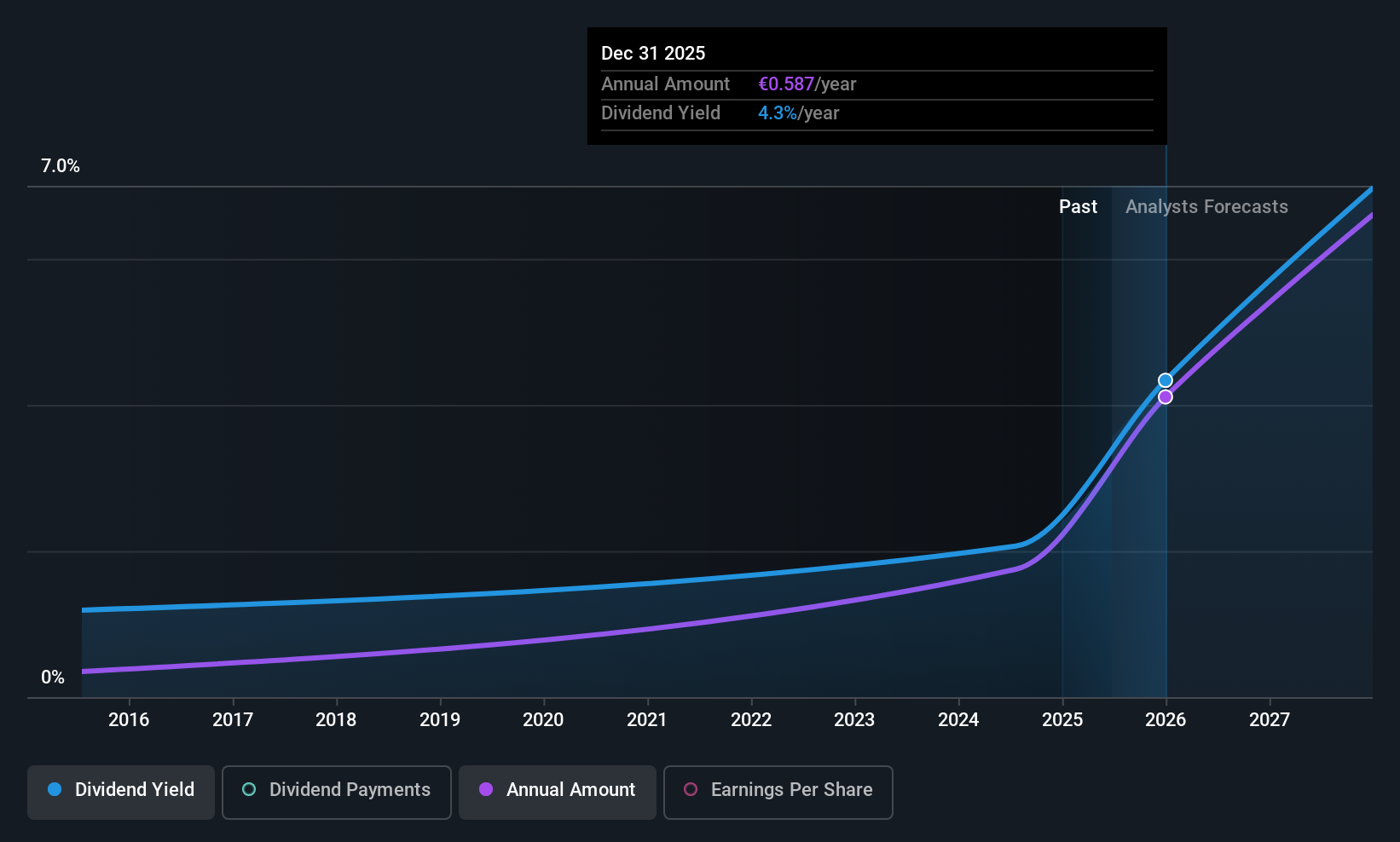Public Power Corporation S.A. (ATH:PPC) has announced that it will be increasing its dividend from last year's comparable payment on the 25th of July to €0.40. Despite this raise, the dividend yield of 3.0% is only a modest boost to shareholder returns.
Public Power's Projected Earnings Seem Likely To Cover Future Distributions
The dividend yield is a little bit low, but sustainability of the payments is also an important part of evaluating an income stock. Before making this announcement, Public Power was paying out a fairly large proportion of earnings, and it wasn't generating positive free cash flows either. We think that this practice can make the dividend quite risky in the future.
According to analysts, EPS should be several times higher next year. If the dividend continues along recent trends, we estimate the payout ratio will be 25%, which would make us comfortable with the dividend's sustainability, despite the levels currently being elevated.

View our latest analysis for Public Power
Dividend Volatility
The company's dividend history has been marked by instability, with at least one cut in the last 10 years. Since 2015, the dividend has gone from €0.05 total annually to €0.40. This implies that the company grew its distributions at a yearly rate of about 23% over that duration. Public Power has grown distributions at a rapid rate despite cutting the dividend at least once in the past. Companies that cut once often cut again, so we would be cautious about buying this stock solely for the dividend income.
Dividend Growth Could Be Constrained
With a relatively unstable dividend, it's even more important to see if earnings per share is growing. It's encouraging to see that Public Power has been growing its earnings per share at 85% a year over the past five years. EPS is growing rapidly, although the company is also paying out a large portion of its profits as dividends. If earnings keep growing, the dividend may be sustainable, but generally we'd prefer to see a fast growing company reinvest in further growth.
Public Power's Dividend Doesn't Look Sustainable
In summary, while it's always good to see the dividend being raised, we don't think Public Power's payments are rock solid. While we generally think the level of distributions are a bit high, we wouldn't rule it out as becoming a good dividend payer in the future as its earnings are growing healthily. We don't think Public Power is a great stock to add to your portfolio if income is your focus.
Companies possessing a stable dividend policy will likely enjoy greater investor interest than those suffering from a more inconsistent approach. Still, investors need to consider a host of other factors, apart from dividend payments, when analysing a company. Case in point: We've spotted 4 warning signs for Public Power (of which 1 can't be ignored!) you should know about. Is Public Power not quite the opportunity you were looking for? Why not check out our selection of top dividend stocks.
New: Manage All Your Stock Portfolios in One Place
We've created the ultimate portfolio companion for stock investors, and it's free.
• Connect an unlimited number of Portfolios and see your total in one currency
• Be alerted to new Warning Signs or Risks via email or mobile
• Track the Fair Value of your stocks
Have feedback on this article? Concerned about the content? Get in touch with us directly. Alternatively, email editorial-team (at) simplywallst.com.
This article by Simply Wall St is general in nature. We provide commentary based on historical data and analyst forecasts only using an unbiased methodology and our articles are not intended to be financial advice. It does not constitute a recommendation to buy or sell any stock, and does not take account of your objectives, or your financial situation. We aim to bring you long-term focused analysis driven by fundamental data. Note that our analysis may not factor in the latest price-sensitive company announcements or qualitative material. Simply Wall St has no position in any stocks mentioned.
About ATSE:PPC
Public Power
Generates, transmits, and distributes electricity in Greece, Romania, Bulgaria, and North Macedonia.
Moderate growth potential with acceptable track record.
Similar Companies
Market Insights
Weekly Picks


Crazy Undervalued 42 Baggers Silver Play (Active & Running Mine)


Fiducian: Compliance Clouds or Value Opportunity?

Willamette Valley Vineyards (WVVI): Not-So-Great Value
Recently Updated Narratives

TXT will see revenue grow 26% with a profit margin boost of almost 40%

Significantly undervalued gold explorer in Timmins, finally getting traction

Moderation and Stabilisation: HOLD: Fair Price based on a 4-year Cycle is $12.08
Popular Narratives


MicroVision will explode future revenue by 380.37% with a vision towards success


NVDA: Expanding AI Demand Will Drive Major Data Center Investments Through 2026





